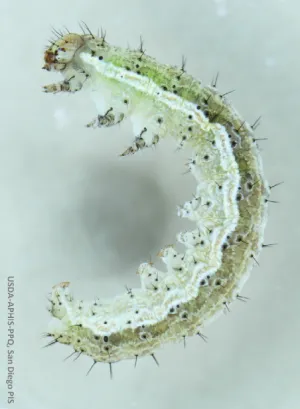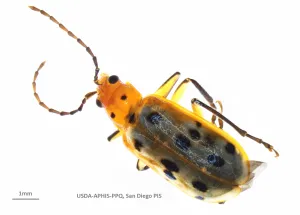OTAY MESA, Calif. – U.S. Customs and Border Protection Agriculture Specialists found something unusual while examining a shipment containing fresh celery, the interception of a rare pest, a first-in-port discovery.
A shipment containing fresh celery, arrived at the Otay Mesa Cargo Facility, Jan. 16. During initial inspection, a CBP Officer referred the driver and cargo load for an intensive agriculture inspection.
At the inspection area, CBP Agriculture Specialists conducted thorough examinations and found one live chrysomelidae and one live lepidoptera within the shipment of celery. The pest was submitted to the United States Department of Agriculture (USDA) Plant Protection and Quarantine (PPQ) Identifiers for further identification. The traveler and shipment were then returned directly to Mexico.
On Jan. 18, the lepidoptera pest was identified by local USDA Animal and Plant Health Inspection Service (APHIS) PPQ Entomologist as actionable Copitarsia species. The chrysomelidae was also later identified by national specialists as actionable Isotes multipunctate (Jacoby). Per local USDA APHIS PPQ, this qualifies as a "first-in-port" for Isotes multipunctate (Jacoby) in the Otay Mesa Cargo Facility.
“Foreign insects, plant and animal diseases, and invasive plants, can be harmful to United States agriculture. It is an important part of the CBP mission to identify and stop pests and diseases at the border prior to entering the country,” said Rosa Hernandez, CBP Otay Mesa Port Director.
Although this not the first time finding this pest nationwide, it is a first-time discovery of this pest at the Otay Mesa Port of Entry. The impressive find demonstrates CBP’s efforts to prevent invasive species from entering the United States, and ways for industry to prevent conveyance contamination. CBP encourages travelers to declare all agricultural items to a CBP officer upon arrival. For more information, travelers are encouraged to visit the Bringing Agricultural Products into the United States section of the CBP website.
CBP officers at the border crossings in Southern California stop illegal activity while processing millions of legitimate travelers into the United States. Those statistics can be found here: CBP-enforcement-statistics
Follow the Director of CBP’s San Diego Field Office on Twitter at @DFOSanDiegoCA for breaking news, current events, human interest stories and photos.



